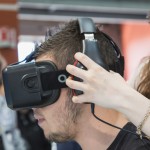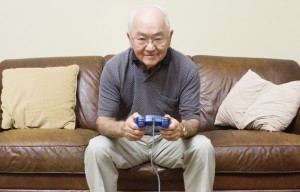
Using virtual reality (VR) in stroke rehabilitation is becoming increasingly popular for a number of reasons. It has the potential to provide the patient with safe environments which can be tailored to meet their needs, it can make boring repetitive tasks more engaging and interesting, and performance can be recorded allowing specific and measurable goals to be set.
VR also offers a variety of mechanisms for therapeutic gain including the repetitive practice of movements, engaging in problem solving, memory and attention tasks. However, attempts to assess the effectiveness of VR therapy have previously been hampered by a lack of high quality studies.
Lohse and colleagues have now partially remedied this in their latest review and meta-analysis.
Aims
As well as updating the literature they set out to compare interventions that had used custom built VR systems to interventions that used commercial games that are available on systems such as the Nintendo Wii or Microsoft Kinect.
Additionally, they set out to explore how VR therapies affect different outcomes according to the International Classification of Function, Disability, and Health (ICF).
The ICF provides a comprehensive framework for assessing the impact of health and disability on the functioning of an individual. Using it to categorise the outcome measures from the different studies included in this review was a novel approach and a real strength of this work.
Results
- A robust methodology was used including the use of the Physiotherapy Evidence Database Scale to assess the quality of the randomized controlled trials (RCTs)
- In total 24 RCTs were included, from an initial trawl of 4512 records
- Only four of these used commercial games, so a reliable comparative analysis of the two different types of VR therapy could not be undertaken
- Taking both therapy types together a meta-analysis of the data showed an overall benefit of VR interventions on improving body function outcomes in adults post-stroke
- They also tested to see if this effect was attenuated by the time post-stroke but this was not the case
- A similar pattern emerged for activity outcomes with significant benefits emerging for those who had received VR therapy compared to controls who had not
- The studies included provided evidence for only two ICF categories. No studies were identified that related to the categories of body structures, personal factors, or environmental factors

Very few published studies investigate the efficacy of commercial games that are available on systems such as the Nintendo Wii or Microsoft Kinect.
Limitations
The authors noted a number of limitations including:
- Potential bias in studies where the patients and therapists were not naive to the experimental hypotheses
- Considerable differences between studies in terms of the participants’ stage of recovery
- Differences in the length of the interventions
- A lack of statistical power in their analyses due to only a few studies meeting the inclusion criteria.
The Stroke Elf view
 The limitations listed by the authors were all valid but in my opinion there is a larger issue associated with VR therapies that needs to be addressed before we can understand the value of this new tool.
The limitations listed by the authors were all valid but in my opinion there is a larger issue associated with VR therapies that needs to be addressed before we can understand the value of this new tool.
This relates to the fact that VR systems are interactive computer generated simulations of the real world whereas VR therapies involve clinicians and therapists making decisions about the person’s ability to interact with the VR system, the types of VR tasks that are the most appropriate, frequency of use, rates of progression etc.
These critical aspects of designing and implementing VR interventions are rarely, and poorly, described. In this respect it would have been a useful addition to this review if the authors had also rated the studies on the seven core elements of VR-based interventions that were described by Lange et al. in 2012.
Links
Lange B, Koenig S, Chang C-Y, McConnell E, Suma E, Bolas M, et al. Designing informed game-based rehabilitation tasks leveraging advances in virtual reality. Disability and Rehabilitation 2012;34(22):1863-70. doi: 10.3109/09638288.2012.670029
Lohse, K. R., Hilderman, C. G. E., Cheung, K. L., Tatla, S., & Van der Loos, H. F. M. (2014). Virtual reality therapy for adults post-stroke: a systematic review and meta-analysis exploring virtual environments and commercial games in therapy. PloS One, 9(3), e93318. doi:10.1371/journal.pone.0093318